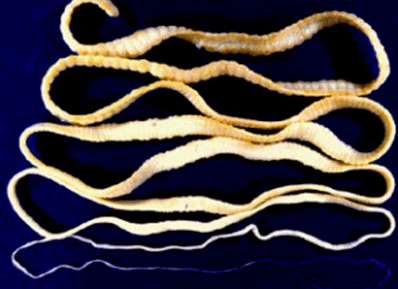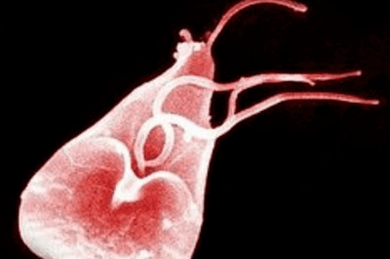Parasitic infection of the body is a frequent phenomenon that can be prone to both children and adults (the first to a greater extent, since they observe hygiene worse).Internal parasites differ in the place of localization in the body in the carrier, their characteristics, structure, life cycle, and also affect the carrier to a greater or lesser extent.Depending on what parasites have appeared in the human body, the symptoms may also differ.

Types
Speaking about what parasitic infection is in human organs, many patients think, first of all, about worms.However, there are many other types of invasions.In the human body, parasites of two types are most common.They have a different life cycle and the nature of the transmission, because they need to be distinguished.
- The first type is worms living in the human body, otherwise called helminths or worms.Hlybon invasion is concentrated mainly in the intestines, gives fairly pronounced symptoms and is easily diagnosed.Also, in general, it is easy to cure it, and it usually does not have serious harm in adults and children.Such parasites come in two types - nematodes (round) and strip worms.It is transmitted by fecal-oral route, that is, in order for parasites in the human body to appear, it is necessary to swallow a significant amount of their eggs, which are emitted with feces;
- Microscopic simple parasites inside a person, amoeba, etc. are not noticeable to the eye.Signs of parasites in the body in this case are more pronounced.It is more difficult to cure them and it is quite difficult to diagnose, unlike the previous type.The effect of parasites on the human body is much more significant, such infections can lead to the development and exacerbation of chronic diseases and even threaten life.The nature of the transmission is fecal-oral, sometimes through blood and some other ways.
It is very important to know about what parasites live in the human body, as this will help to avoid infection.
Types
Parasites cause a variety of symptoms.Usually, it is localized in the organ or system that they amaze.Depending on the species, parasites in the body can lead vital activity, eat and multiply only under certain conditions.Based on this, they are conditionally divided into species:
- Intestinal (mainly round and flat worms - pinworms, ascarides, tapeworms);
- Liver (mainly microscopic protozoa - lamblia, etc.);
- Muscle (also, mainly microscopic);
- Joint (the same as in the previous case);
- Skin (micro-hot, fungi);
- Cardiac (mainly microscopic or damage by helminth larvae);
- Pulmonary (infection with worms with worms);
- Brain (larval forms of worms and simple organisms);
- Parasite in human blood (microscopic protozoa);
- Genital in the uterus, vagina (usually worms, but the phenomenon is quite rare).

Each of the listed groups causes certain signs of parasites in the human body.Therefore, in order to diagnose infection in a timely manner, you need to know what can cause it.
Localization
Although there are a lot of places where parasites live in the human body, as can be seen from the groups of parasites listed above, the most common are worms.These worms are localized, mainly in the intestines.Depending on the species, they can live in a small or large intestine.There they multiply, lay eggs and eat.That is, the active stages of their life cycle are underway.
These parasites in humans have a migration stage in which larvae fall into other organs (lungs, liver, brain, heart, muscles, etc.), striking them.This is due to the fact that from the intestines they fall into the local, and then into a common bloodstream.So parasites in a person fall into all organs and systems.But there they form a capsule around the larva and go into a state of rest.However, they cause the development of inflammatory processes, abscesses, Sepsis.
Other persons of a person, for example, giardia, settle in the liver.There, the most favorable environment is present for them, and therefore in the intestines and other systems they are in minimal quantity.The same way of life is a bicom.These parasites can draw the minimum part of their life cycle in the intestines, mainly affecting other organs.
Some parasitic organisms live on the body of the carrier.These are mainly fungi of one or another type.Depending on the species, they affect the skin, nails, the scalp, the mucous membranes.Micro-glow is another type of pest that lives on the skin and in its upper layers.
General symptoms
Symptoms of the presence of parasites in the human body vary depending on which type of invasion has struck the body.But almost everyone is characterized by two signs - intoxication and allergic syndrome.
- Intoxication develops as a result of poisoning of the body with the products of parasites.It is caused by absolutely all types of parasites in the body.It is expressed as a constant weakness of the carrier, its pallor, increased fatigue, chronic fatigue, drowsiness.In children, intoxication can be expressed quite strongly, in adults - to a lesser extent;
- The second common phenomenon that provokes parasites in the human body is the symptoms of allergies.This is due to the fact that the immune system, trying to protect the body from an alien agent, triggers the active production of histamine.If a lot of blood accumulates in the blood, then allergies develop.Usually, the symptoms are predominantly skin - rashes, urticaries, but can also be respiratory.
At the stage of diagnosis about parasites in the body, we can conclude by the presence of specific immunoglobulins in the blood test.Regardless of the nature of the invasive agent, the immune system produces specific antibodies to combat it.If there are such antibodies, then there is invasion in the body.And by type of antibodies you can understand which one.
Specific symptoms
How parasites affect the body depends on their type.Each has specific symptoms of infection with parasites.Extracurricular forms of infection with internal parasites (Lambliosis, Toxocarosis, Opistorhoz, etc.), as well as helminthic invasions with active infection of internal organs in the migration stage are especially difficult.The first signs with this flow are as follows:
- Increasing body temperature, usually significant;
- Chills;
- Abundant sweating;
- Sometimes there is an increase in lymph nodes;
- If the parasites struck the lungs, then there will be a slight coughing, which over time can intensify and even go into pneumonia;
- If the liver is defeated, then it increases, its soreness is observed;
- When localized on the skin, rashes and redness, peeling, itching appear;
- With intestinal worms, abdominal pains, bloating, flatulence, nausea, weight loss, can cause constipation or diarrhea;
- With localization in the organs of the cardiovascular system, heart, arrhythmias, tachycardia, and other rhythm disturbances are observed;
- Pain arising from parasites in the muscles and joints are not pronounced and appear periodically in the affected areas.
It can be said that human parasites are present in the body, other symptoms can also, but the above are the most characteristic.The most characteristic evidence that intestinal worms are in the body is the detection of individuals in a chair.
Treatment
Helminths or simplest can live in a person long enough, without showing themselves.However, if suspicions of the invasion, you need to immediately undergo diagnostics and make a diagnosis.A parasitologist or infectious disease specialist will tell how to treat infection.
Helminth treatment is carried out using anthelmintic drugs.All specific drugs are divided into two groups.Preparations with a wide spectrum of action kill parasites of several types and are prescribed for invasion with an unclear pathogen.Preparations with a narrow spectrum are prescribed when an invasion agent is installed, they are less toxic.
A person should take such a drug once.After 7-10 days, a second reception is prescribed as protection against possible self-invasion.Sometimes the drug can be prescribed in a short course of 3-5 days.Dosages depend on the degree of invasion, type of drug, patient weight and other factors.



























